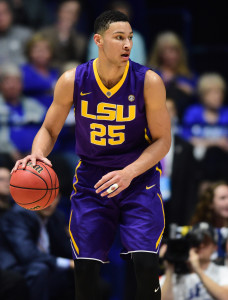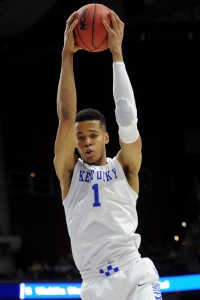PROJECTED DRAFT RANGE: Chad Ford of ESPN.com has Simmons ranked as the best prospect, while Jonathan Givony of Draft Express has him behind only Brandon Ingram. Givony has concerns about Simmons playing up to his full potential and believes the 19-year-old has the instincts and anticipation skills to be a terrific defender, but questions his effort on that end of the floor. Overall, Simmons’ approach to the game appears to be the reason he isn’t the DraftExpress choice for the No. 1 overall pick.
RISE/FALL: Simmons isn’t falling below No. 2 barring a serious injury between now and the June 23rd draft. It wasn’t until the end of the season, during a horrendous SEC tournament appearance, that chatter started to pick up about him not being the top selection. Ingram is the only challenger for the top spot and it may come down to who wins the lottery to determine the top overall selection. Make no mistake, the Rich Paul client is still likely to go No. 1.
FIT: The Sixers have the highest chance at landing the No.1 overall pick, as our Reverse Standings indicate. Philly has a 26.7% chance at the top spot, with a quarter of the pingpong balls for being the worst team, plus an additional 1.7% chance at the selection, since the team can swap picks with the Kings and would do so should Sacramento win the lottery. Picking Ingram instead of Simmons makes sense for the Sixers based on the team’s glut of big men. Having Jahlil Okafor, Nerlens Noel, Joel Embiid and Dario Saric all on the roster crowds the paint, but the Sixers could very well trade multiple members of the big man boy band they have assembled sometime this summer.
The Lakers have the second-best odds of landing the top pick, and they have no such roadblocks to playing time. Los Angeles would give Simmons a great situation to grow as a player. He and D’Angelo Russell attended the same high school, where they led their team to a national championship. The duo reportedly have spoken about playing together for the Lakers, according to Kevin Ding of Bleacher Report.
The Pelicans would be a fascinating fit for Simmons. They only have a 13.3% chance at a top-two selection, but they likely have the best frontcourt partner to offer Simmons in Anthony Davis.
The Kings would likely be the worst fit due to their ever-changing front office and recent history of inadequate player development. Sacramento won’t take home the No. 1 selection, as a result of its trade with Philadelphia, but it could get the No. 2 pick in one of two ways: the Sixers winning the lottery and the Kings landing No. 2 (0.5% chance of this occurring) or the Kings winning the lottery with the Sixers landing No. 2 and subsequently swapping picks (0.37%). In either of theses unlikely scenarios, it would take Philly selecting Ingram for Sacramento to land Simmons.
Every team could use a talent like Simmons and he would change the fortunes of any franchise. Ultimately, it will come down to the May 19th draft lottery to determine where he ends up.
FINAL TAKE: Pessimists may say the glass is half full and those people may look at Simmons as a nonshooting big man who doesn’t try hard enough. In reality, Simmons has enough in his glass to warrant being the top selection, and with the right coaching and tutelage, he could make any franchise’s cup runneth over.
(For Part One of Ben Simmons’ Prospect Profile, click here.)




